Worms: The Ideal Food for Caudates
By Jennifer MackeIntroduction
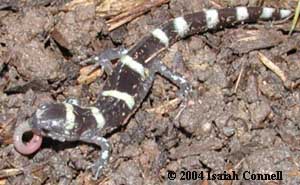
Everyone who keeps newts or salamanders for any length of time uses some kind of worms to feed them. Caudates and worms are a match made in heaven. In fact, I would go so far as to say that if you can't tolerate worms, you shouldn't keep newts or salamanders at all.
This article presents the kinds of worms that are commonly used and explains where to get them. It shows how to feed a large worm to a small newt, how to enrich the nutritional value of worms, and how to grow your own earthworms.
Note: As I live in the United States, the common names and sources given may apply uniquely to the U.S. I apologize to readers in other countries, but I could not think of any better way to organize the article. If anyone would like to write some information regarding the names and sources of worms in other countries, I would be happy to add that.
Part I: Types of worms and where to get them.
Various small worms.
- Microworms (Panagrellus spp.)
- Whiteworms (Enchytraeus spp.)
- Tubifex (Tubifex spp.)
These smaller worms are discussed in the article Microfoods for Caudate Larvae. With the exception of microworms, these small worms are also suitable foods for some adult caudates. Most of them are only available in the U.S. as starter cultures, meaning that you have to grow your own.
Blackworms (Lumbriculus variegatus).
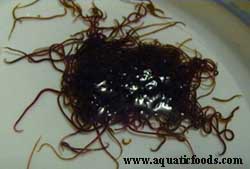
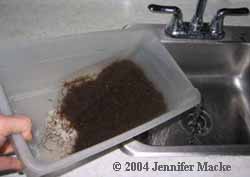
These aquatic worms are widely available in the U.S., and are a fantastic food source, particularly for young newts and picky eaters. While they can be grown in culture, they reproduce too slowly for this to be practical.
Other names: Some pet shops mistakenly call them "live bloodworms" or "tubifex", but they are not. See photos.
Availability: In the U.S., live blackworms are sold in many pet stores. They can be obtained in large quantities by mail from Aquatic Foods. In the UK, they are not commonly available.
Keeping live blackworms alive: Blackworms can be stored in the refrigerator for weeks, but they do require some care.
- Keep cold. They can survive for periods of time without refrigeration, but they will "age" faster that way.
- Don't drown them. The worms should not be too deep in the container. The water should just barely cover them.
- Rinse daily with refrigerated, aged water. Although chlorine is not good for them, chemical dechlorinating drops may be worse. If you have chlorine in your water, age it before using for blackworms. If you have chloramine in your water, age it with some pieces of filter carbon.
- Once some of them start to die, it's hopeless. If more than a few die, or the whole container stinks, throw them away immediately. Healthy blackworms may have a faint "earthy" smell, but should not smell foul.
- Find out what day of the week they arrive fresh to your pet store, and only buy fresh ones. Pet stores often do not rinse and store them properly. They will often try to sell you their older ones, unless you specifically request the freshest ones. Also, in hot weather, their fresh ones may arrive in a state of decay.
- When you get a new batch of blackworms, rinse them several times and keep them for a day before use. This gives you time to rinse away any dead ones and make sure they are healthy before feeding them to your animals.
Blackworm links:
Lumbriculus variegatus: A Biology Profile
Black Worms... keeping and breeding
Aquatic Foods
Bloodworms (Chironomus spp.).
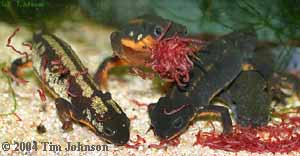
These are not really worms, they are insects (the aquatic larvae of midge flies). They are normally bright red and have visible body segments. I included them here only to help resolve the confusion about what is (and isn't) a "bloodworm".
Other names: Midge larvae
Availability: In the UK, live bloodworms are commonly sold in pet stores. In the U.S., live bloodworms are very rare, but frozen ones are sold in almost every pet store.
Canadian nightcrawlers (Lumbricus terrestris).
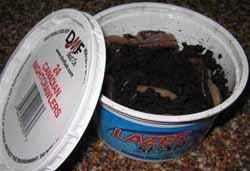
These are large worms. They are not commonly grown in culture (as they require cold temperatures and have different needs than compost worms), but they are widely available for sale. Despite their large size, these worms are the staple food used by MANY caudate keepers. They can be fed even to very small salamanders (see Part II).
Other names: In Europe, these are considered "regular earthworms".
Availability: Available in nearly every baitshop and Wal-Mart store (in the fishing department). Also sold at some gas stations and K-Marts.
European nightcrawlers (Eisenia hortensis, formerly Dendrobena [or Dendrobaena] veneta).
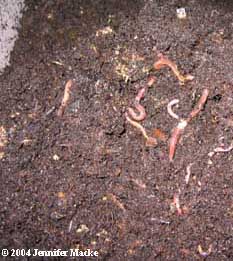
These are large worms suitable for culturing.
Other names: Belgian nightcrawlers, trout worms
Availability: May turn up in some bait shops. Sold online.
Red wigglers (Eisenia fotida [or foetida] and Eisenia andreii).
These small earthworms grow to about 2 inches (5 cm). Although nutritious, they may be unpalatable to some newts and salamanders, as they exude a foul-smelling yellow liquid when chopped. They work well when they can be fed whole. Also, many salamanders will learn to accept them despite the odor.
Other names: Bloodworms, manure worms, compost worms, tiger worms
Availability: Widely available. Sold at PetsMart and many bait shops. Can be cultured.
Leaf worms (Lumbricus rubellus).
Other names: Redworms, red marsh worms
Availability: May turn up in some bait shops. Sold online and on eBay.
Dug worms (various species).
Basically, these are just the medium-sized gray worms that you dig up in your garden. They are the ideal food, but require some work.
Availability: Anywhere that is reasonably free from pesticides and other lawn chemicals.
Part II: How to feed a large worm to a small newt.
Note: This series of photographs may be objectionable to the squeamish. Please remember that the worm shown would have ended up on a hook if it had not been used as salamander food. Click here to view article.
Part III: Gutloading worms.
Why? Good question! In most cases, people use worms straight from the bait cup. Indeed, worms are nutritious without any further treatment. But if you want to supplement your worms for added nutrition, it may be beneficial.
Method 1: Feeding the worms. Put the worms in a plastic tub with bedding (damp coconut fiber or soil). Feed with fish food or newt pellets. A pinch of calcium/vitamin powder or paprika (for carotene) can be added to the food. Be careful to use very small amounts of food. They don't eat much, and uneaten food will get moldy.
Method 2: Stuffing the worms. Take the worm straight out of the bait cup and cut into pieces (see Part II). Using tweezers or a toothpick, stuff the gut cavity of the worm piece with newt pellets or trout/salmon pellets.
Part IV: Vermiculture: Growing your own worms.
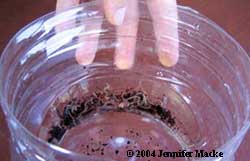
Why? You might want to grow your own worms for the following reasons:
- To obtain a steady source of small earthworms. Small worms are an excellent resource for feeding small caudates.
- To reduce the amount of garbage you send to the landfill by composting it.
- To produce fertile compost for gardening.
What kind? The usual worms for home compost are red wigglers and European nightcrawlers. While red wigglers (E. fetida spp.) have the fastest reproduction, they are unpalatable to some amphibians when cut. European nightcrawlers (E. hortensis) reproduce more slowly, but are a good option. It may also be possible to grow leafworms and dugworms under similar conditions.
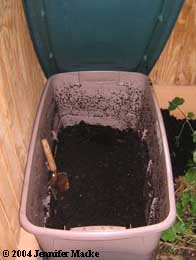
Where? A greenhouse, basement, garage, or buried outdoors are all good locations. A worm bin that is kept in the garage in winter can be moved to a shady outdoor spot in summer to avoid excess heat. Worms can also be kept indoors. A worm culture does not stink, but it does tend to attract insect pests.
There are commercially-available worm bins available, but an adequate container can be set up easily for a lot less money. An outdoor "pit" can be dug, lined with cement blocks and covered with old carpet. Any plastic tub can serve, but it needs to be drilled for drainage and ventilation (holes should be smaller than most of the worms).
How? Worms have only a few basic needs:
- A container. Must provide ventilation, allow drainage, and minimize escape. Keeping them outdoors provides other options.
- Bedding material (something light weight that retains moisture, such as coconut fiber, peat moss, shredded paper or leaves).
- Food, such as fruit and vegetable scraps.
DOs and DON'Ts
- DO keep the culture within comfortable temperatures: 0-30°C (32-85°F).
- DO expect to spend some time picking out worms, especially if you need small ones. Harvesting isn't quite as easy as buying worms in a cup!
- DO use fruit scraps. Worms are very fond of melon rinds and banana peels. Avoid citrus, as it is too acidic.
- DO bury the food under the bedding. This will reduce the invasion of pests.
- DO add crushed egg shells to prevent acid conditions and supplement calcium.
- DON'T overfeed. Just like any enclosed system, too much food will foul the bedding and sicken or kill the worms.
- DON'T panic when you find other "critters" living with the worms. Other invertebrates will invariably move in, but these are very unlikely to harm the worms or the salamanders you feed them to.
© 2004 Jennifer Macke. Posted November 2004.
